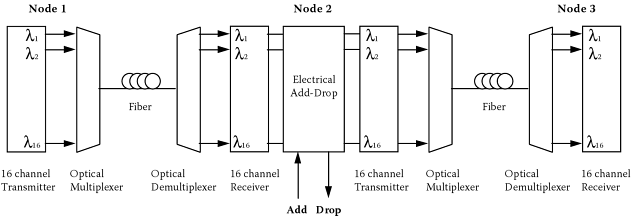There are several trends for transceiver development with the majority of activities occuring at 10 Gbps, where DWDM XFPs are increasingly being deployed. Additionally, there is another new MSA standard called Quad Small Form Pluggable (QSFP), that is pushing the bit-rate to a 16-Gbps limit, thus promising a 3-times density improvement over current solutions. Jobs are being done in high channel count DWDM systems for short reach ultra high bandwidth interconnection applications. The next challenge would be 40-Gbps transceivers and current DWDM technologies would play a more significant role, as bit rates increase and also the impairments from chromatic dispersion as well as polarization mode dispersion become harder to handle.
SFP transceivers are currently used for CWDM applications providing a full 16/18-channel support for bit-rates up to 2.5 Gbps with integrated monitoring functions and hot-plug capability. They represent the inspiration, which allow an easy and cost-effective design of standard CWDM transmission links. With these existing transceivers (CWDM SFP), variations within the CWDM link design are limited. For new requirements for the CWDM systems, novel transceiver concepts would need to find their way into CWDM.
The trends here will be capacity/performance, modularity, and integration, and therefore are briefly discussed next.
- 1. Capacity/Performance
When pushing the road rates to 10 Gbps and beyond, the aforementioned LX-4 or QSFP approach could help to distribute the capacity among four separate channels and for that reason revert towards the low-cost sources. However, when all 16 channels are allocated and no extra spectral bandwidth can be obtained, this concept no longer works and exiting channels need to be migrated toward higher bit-rate, depending on the individual demand. Here, the brand new developments in neuro-scientific 10-Gbps transceivers could find their application.
- 2. Modularity
Another trend for CWDM could be wavelength agnostic transceivers where the operating wavelength can be controlled externally. The idea behind this really is to reduce inventory costs, rather than 16 individual transceivers; just one module type might be deployed that covers all wavelengths. This also facilitates the upgrading of existing channels with new wavelengths or the keeping spares for existing channels. Tunable laser devices that are currently employed for DWDM are not a viable option for CWDM. It’s because the relatively high cost, the complexity, and also the inability of the current technology to extended tuning wavelength range of the current C-band to cover a reasonable quantity of CWDM channels.
- 3. Intergration
The trend toward bandwidth links has additionally led to the development of multi-channel transmitters and receivers. These devices typically have multiple lasers in bar configuration and a multi-channel driver IC in the transmitter case along with a photodetector array and 2R regeneration IC within the receiver implementation. The present SNAP 12 MSA allows for 12 separate transmit channels in one module with a corresponding 12-channel receiver unit. The SNAP 12 currently operates at 3.125 Gbps per channel over Multi-Mode Fiber (MMF), with lab results that have shown performance above 8 Gbps. Without any optical multiplexing element contained in the channel, this design would be limited to the number of channels obtainable in a ribbon fiber. Currently, the practical limitation for parallel optics modules is 12 channels, it’s because the ribbon fiber count and number of connections possible in MT-type connectors, (the conventional connector type for parallel optics modules today). The combination of multiple wavelength transmitters with optical multiplexers and long width demultiplexers and receivers is going to be challenging from the point of heat dissipation, crosstalk, and footprint. However, the best goal will be a 16-channel transceiver where all the required optics, that is, transmitter, receiver, and multiplexers along with demultiplexer (MUX/DEMUXes) would be integrated in one module.


The approach of highly integrated transmitters and receivers has already been shown for 10-Gbps DWDM systems. Following a same path, a single channel fiber link might be easily enabled to supply the capacity of CWDM by adding these modules, as shown in the figures below. Even extended reach or networking functionality would be possible be multiple optical-electrical-optical sites in which the receiver-transmitter (transceiver) arrays operate as repeaters.
Recommended: To spearhead, the Fiberstore company has been providing the newest CWDM solutions for years. As Cisco CWDM devices are too expensive, we’re trying our best too give people a far more cost-effective choice that is an equivalent towards the Cisco CWDM products and fully compatible with all the Cisco devices.